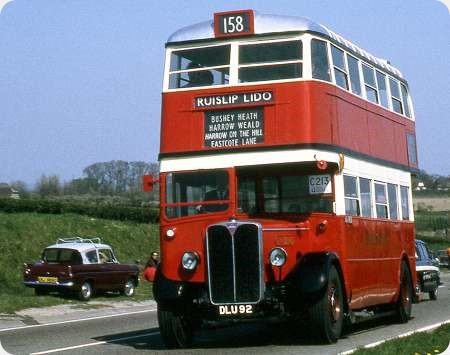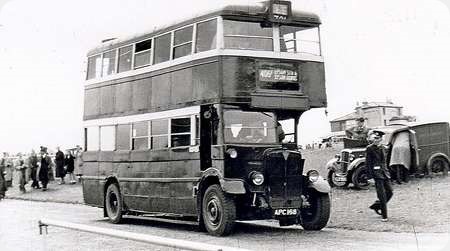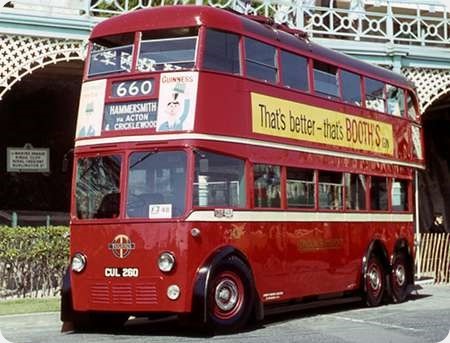
London Passenger Transport Board
1937
AEC Regent O661
London Transport Chiswick H30/26
The STL – the letters stand, rather confusingly, for ‘Short T Long’ – was introduced into London area service firstly by Thomas Tilling in October 1932 and then by the London General Omnibus Company in January 1933. The STL Regent then became the standard double decker for the new London Passenger Transport Board which came into being on 1 July 1933. The chassis was the latest version of the AEC Regent which took advantage of new regulations that allowed for the extension of the overall length from 25ft to 26ft on a wheelbase of 16ft 3ins, and an increase in the rear axle loading from 9½ to 10 tons. The LPTB STL class then reached a total of 2647 by the commencement of war in 1939, and a further 34 unfrozen chassis were added from the end of 1941. Twenty more buses complemented the STL class in 1946, but these were very different beasts from the LPTB specification, being standard post war AEC Regent II machines with provincial style Weymann bodywork. An example of which can be seen here
The STL class underwent several specification changes over its production run and subsequently in service – engine changes (petrol/indirect injection diesel/direct injection diesel) and many bodywork swaps, some arising from the attrition of wartime. STL 2093, DLU 92, seen above during the HCVC Brighton rally of May 1971, was a 1937 chassis powered by the AEC A171 indirect injection 7.58 litre diesel driving through the AEC D132 four speed spring operated preselector gearbox. It was initially bodied by Park Royal, but, being damaged in an air raid, it was sent to Birmingham City Transport for repair in 1944. By 1949 the body was deemed past further use and it was scrapped in February of that year. STL 2093 then received the Chiswick built body from 1939 vintage STL 2570, the chassis of which was then selected to join the expensive and ultimately fruitless SRT conversion programme, under which newer STL chassis were ‘upgraded’ to carry the heavier RT bodywork. Sadly, not only were the SRTs under powered but, more seriously, they couldn’t stop, and the whole wasteful exercise was abandoned ignominiously. This OBP entry contains comments on the SRT debacle. www.old-bus-photos.co.uk/
Meanwhile, now carrying its Chiswick body, STL 2093 soldiered on, even seeing a short spell during 1949 as a Green Line coach on route 703 at Swanley, until its withdrawal from passenger service in 1954 along with the rest of the pre-war/wartime STL class. It was then sold in 1955 to Reliance Services of Newbury who in turn passed it on to a private owner for preservation in May 1958. This was Dennis John Cowing, a chemistry master (and transport enthusiast) at Selhurst Grammar School in Croydon, a master contemporary with my own attendance in a less elevated capacity at that establishment. Mr Cowing rallied the bus for many years and he is driving it in the 1971 picture, but, by 1976, the structure of the vehicle had degenerated alarmingly and it passed into the ownership of Prince Marshall for full restoration. That has since proved to be a mammoth undertaking, currently in the hands of the former Cobham, now Brooklands Museum, where it has more recently been displayed as a bus victim of the blitz.
www.londonbusmuseum.com/
I have gleaned information from various sources for this note, but, as ever, Ian’s Bus Stop has been invaluable.
Photograph and Copy contributed by Roger Cox
26/03/20 – 06:43
One of my favourite buses, in roof-box form, along with the Bluebird LT’s. A shot which brings out the best of its design and in a condition which suggests it’s only been on the road for a few weeks after delivery to LT. Only the parked Ford 105E gives the game away! Yours, Roger? My last glimpse of a working STL was in June 1955. When waiting at traffic lights, one passed across me. It must have been a garage hack on one of its last journeys.
Chris Hebbron
29/04/20 – 06:19
This bit of Pathe newsreel, taken in 1946, includes shots of many LT types including STLs. I was surprised that so many horse drawn vehicles were still extant and also by the number of private vehicles on the road in addition to London taxis in a time of petrol rationing. Some of the pedestrian behaviour is decidedly death dicing. www.youtube.com/watch?
Roger Cox
30/04/20 – 06:03
A wonderful piece of film there Roger with a fascinating array of buses but strangely, given the date of 1946, I spotted only one utility, GYE 51. Were utilities kept off central London routes to any extent?
Chris Barker
02/05/20 – 06:36
A real cornucopia of LTs (one open staircase, with half its windows still boarded up), STs, pre-war STDs, STLs all still with their white discs on the back, and, surprise, surprise, the lone surviving TF9, on a ‘SEEING LONDON TOUR’ and still in its pre-war livery.T wo ex-army lorries, one a 3 ton Bedford OY model, which I recall as being ubiquitous post-war.
Very pleasurable to watch – thanks Roger.
Chris Hebbron
03/05/20 – 06:21
Well spotted, Chris B. As Chris H can confirm, GYE 51 was Brush highbridge H30/26R bodied Daimler CWA6 D62, allocated to Merton garage. Pretty certainly it is seen here on route 88, Acton Green – Clapham Common – Mitcham which did run through central London via Marble Arch and Parliament Square. That route is reputed to have given rise in Victorian times to the term, "The Man on the Clapham Omnibus". The Daimlers were based at Merton and Sutton garages, apart from a brief period when a few were painted green and allocated to Romford for the reintroduced Green Line routes from Aldgate. The wartime London Bristol K types, the K5Gs were later converted with AEC engines to conform with the later K6A batch, were all allocated to Hanwell. The Guy Arabs operated mainly in eastern and northern sides of London, but Victoria garage had an allocation along with its Leyland TD7 unfrozen utilty bodied buses. The heavy 5LW powered Guys, with their ‘back to front’ crash gearboxes and rather ponderous clutches were not popular with London drivers, but the TD7s were truly detested at Victoria owing to their high gearing and the heavy engine flywheel designed to damp out rock from the flexible engine mountings. This resulted in a requirement to wait excessively for the revs to die for upward gear changes, and keeping time with the type was nigh impossible. In practice, those TD7 mountings were unreliably weak, and many other operators bolted them up solid. The whole exercise was a bit pointless anyway since the rigid mountings of the TD5 were entirely adequate for the smooth running 8.6 litre Leyland engine. Those TD7s were the first wartime buses to be sold off by London Transport, when they all went for scrap. The appearance of private hire TF9 in the film is remarkable as, by 1946, it was unique, its fellows having been destroyed in October 1940 by enemy action. The prototype TF1 did survive the war but was sold off early in 1946. The Green Line TF fleet was withdrawn and sold by 1953.
Roger Cox
03/05/20 – 06:22
Chris Barker – During my working time in London from 1951 to 1956, I worked in Shaftesbury Avenue and would often walk around the whole West End, especially Regent Street, Piccadilly Circus, Haymarket, Trafalgar Square and although I never saw any Utility G’s (Guys), there were their cousins, the utility D’s (Daimlers) who went up these roads. They worked the 88 route, which went from Clapham Common (Old Town) to Shepherds Bush. These D’s worked out of Merton Garage. Other routes they operated on were the 77/77A, all going through Westminster, terminating at Kings Cross, plus the 137 going through Knightsbridge and Oxford Circus. I seem to recall that most of the G’s were garaged in East London, but I never recall seeing any around Holborn or the City. Others will probably help on that score. The following link maybe of interest London Transport – Daimler CWA6 – GXV 785 – D 54
Chris Hebbron
04/05/20 – 05:49
One wonders why the unfrozen STD TD7s were ever allocated to Central London. They’d have been more suited to Country Area, or at least to less challenging Central Area routes.
Chris Hebbron
31/07/20 – 09:36
GYE 51 would pass to Belfast Corporation in December 1953 becoming No.467. It would be rebodied with a new Harkness metal framed body in 1955 and would serve until 1970.
Bill Headley
01/08/20 – 06:27
The earliest of the Highbridge Daimlers were delivered to LPTB in August 1944, the era of V1 and V2 bombings, but not one of them suffered from this German onslaught. Ironically, a few of these went to Belfast, and a couple of them were destroyed in the early days of the ‘Troubles’. Fortunately, this was from the mid-1960s, near the end of their service lives.
Chris Hebbron



